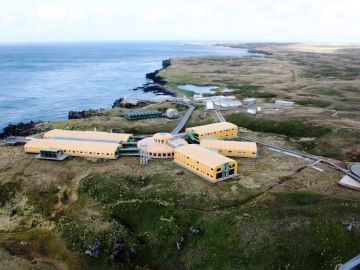New-base-aerial_360 px width.jpg

Marion Island is located between South Africa and Antarctica. Crews visit for a year at a time to study the Southern Ocean. Image courtesy of the Department of Forestry, Fisheries and the Environment, Republic of South Africa.
Marion Island is cold, windy, and remote—about half way between Antarctica and the southern tip of Africa. That makes it a great spot for studying the Southern Ocean—from the weather to the seas to the abundant life. In fact, a dozen or more hardy souls spend 13-month stretches doing just that.
Marion Island is owned by South Africa. It’s the peak of a volcano, which last erupted in 2004. It measures about 10 miles wide by 15 miles long.
The island is packed with life, including three species of seals. There are also lots of birds. In addition, killer whales are common in the waters around the island. And about 30 species of seabirds nest there, while others hang out for parts of the year—millions of birds in all. The list includes four species of penguin, five species of albatross—all of them threatened or endangered—and 14 species of petrel.
South Africa established a weather station on Marion in 1948, and has kept it going ever since. Over the decades, the research base has expanded to study the ocean and its life.
A ship visits once a year—usually in April—bringing a new crew of scientists, engineers, and support staff. It also drops off work teams to repair and upgrade the base and stage supplies for the coming year. The ship then carries marine scientists out to sea for a few weeks of research before returning to the island to pick up the departing crew—beginning another year of work on this remote outpost in the Southern Ocean.

